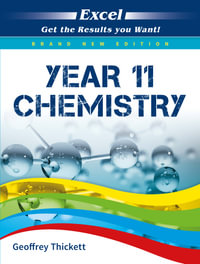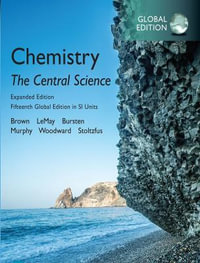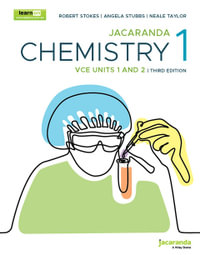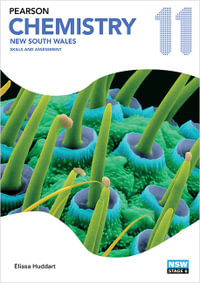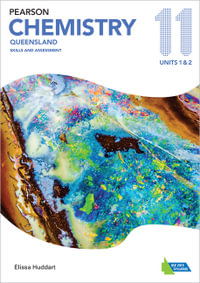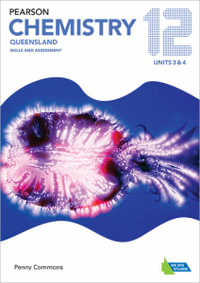
Jacaranda Chemistry 2 VCE Units 3 and 4, 3e learnON and Print
By: Robert Stokes, Angela Stubbs, Neale Taylor, Jason Bourke, Ben Williams
Paperback | 14 November 2023 | Edition Number 3
At a Glance
Paperback
RRP $90.00
$88.25
About This Resource ix
Acknowledgements .xvi
Unit 3 How Can Design and Innovation Help to Optimise Chemical Processes? 1
Area of Study 1 What Are the Current and Future Options for Supplying Energy?
1 Carbon-based fuels 3
1.1 Overview 4
1.2 What are fuels? 5
1.3 Thermochemical reactions 24
1.4 Fuel sources for plants and animals 39
1.5 Review 48
2 Measuring changes in chemical reactions 55
2.1 Overview 56
2.2 Fuel calculations 57
2.3 Energy from food and fuels 66
2.4 Calorimetry 73
2.5 Review 88
3 Primary galvanic cells and fuel cells as sources of energy 99
3.1 Overview 100
3.2 Redox reactions 101
3.3 Galvanic cells and the electrochemical series 112
3.4 Energy from primary cells and fuel cells 131
3.5 Calculations involved in producing electricity from galvanic cells and fuel cells 148
3.6 Review 159
Area of Study 1 Review 171
Practice examination 171
Practice school-assessed coursework 177
Area of Study 2 How Can the Rate and Yield of Chemical Reactions Be Optimised?
4 Rates of chemical reactions 179
4.1 Overview 180
4.2 Factors affecting the rate of a chemical reaction 181
4.3 Catalysts and reaction rates 192
4.4 Review 201
5 Extent of chemical reactions 213
5.1 Overview 214
5.2 Reversible and irreversible reactions 215
5.3 Homogeneous equilibria 219
5.4 Calculations involving equilibrium systems 227
5.5 The reaction quotient (Q) 236
5.6 Changes to equilibrium and Le Chatelier’s principle 240
5.7 Review 261
6 Production of chemicals using electrolysis 273
6.1 Overview 274
6.2 What is electrolysis? 275
6.3 Using the electrochemical series in electrolysis 282
6.4 Commercial electrolytic cells 295
6.5 Rechargeable batteries (secondary cells) 304
6.6 Contemporary responses to meeting society’s energy needs 314
6.7 Applications of Faraday’s Laws 327
6.8 Review 335
Area of Study 2 Review 347
Practice examination 347
Practice school-assessed coursework 352
Unit 4 How Are Carbon-based Compounds Designed for Purpose? 353
Area of Study 1 How Are Organic Compounds Categorised and Synthesised?
7 Structure, nomenclature and properties of organic compounds 355
7.1 Overview 356
7.2 Characteristics of the carbon atom 357
7.3 Structure and systematic naming 363
7.4 Functional groups 374
7.5 Isomers 389
7.6 Trends in physical properties 393
7.7 Review 405
8 Reactions of organic compounds 413
8.1 Overview 414
8.2 Substitution, addition and oxidation reactions 415
8.3 Condensation and hydrolytic reactions of esters 425
8.4 Hydrolytic and condensation reactions of biomolecules 434
8.5 The production of chemicals and green chemistry 454
8.6 Review 466
Area of Study 1 Review 475
Practice examination 475
Practice school-assessed coursework 481
Area of Study 2 How Are Organic Compounds Analysed and Used?
9 Laboratory analysis of organic compounds 483
9.1 Overview 484
9.2 Tests for functional groups 485
9.3 Laboratory techniques for analysis of consumer products 496
9.4 Volumetric analysis by redox titration 506
9.5 Review 519
10 Instrumental analysis of organic compounds 527
10.1 Overview 528
10.2 Mass spectrometry 529
10.3 Infrared spectroscopy 540
10.4 NMR spectroscopy 551
10.5 Combining spectroscopic techniques 566
10.6 Chromatography 580
10.7 Review 598
11 Medicinal chemistry 613
11.1 Overview 614
11.2 Structures and isolation of organic medicines 615
11.3 Enzymes and inhibitors 627
11.4 Review 650
Area of Study 2 Review 659
Practice examination 659
Practice school-assessed coursework 666
Area of Study 3 How Is Scientific Inquiry Used to Investigate the Sustainable Production of Energy
And/or Materials?
12 Scientific investigations
12.1 Overview
12.2 Key science skills and concepts in chemistry
12.3 Characteristics of scientific methodology and primary data generation
12.4 Health, safety and ethical guidelines
12.5 Quality of data and measurements
12.6 Ways of organising, analysing and evaluating primary data
12.7 Models, theories and the nature of evidence
12.8 The limitations of investigation methodology and conclusions
12.9 Presenting findings using scientific conventions
12.10 Review
Area of Study 3 Review
Practice past VCAA exam questions focused on key science skills.
Answers 673
Glossary 739
Index 749
Appendix Periodic table of the elements 758
ISBN: 9781119886143
ISBN-10: 1119886147
Series: VCE Chemistry series
Published: 14th November 2023
Format: Paperback
Language: English
Number of Pages: 784
Audience: Primary, Secondary and High School
Publisher: John Wiley & Sons Australia
Country of Publication: AU
Edition Number: 3
Edition Type: Revised
Dimensions (cm): 28 x 21.5 x 3
Weight (kg): 1.55
Shipping
| Standard Shipping | Express Shipping | |
|---|---|---|
| Metro postcodes: | $9.99 | $14.95 |
| Regional postcodes: | $9.99 | $14.95 |
| Rural postcodes: | $9.99 | $14.95 |
How to return your order
At Booktopia, we offer hassle-free returns in accordance with our returns policy. If you wish to return an item, please get in touch with Booktopia Customer Care.
Additional postage charges may be applicable.
Defective items
If there is a problem with any of the items received for your order then the Booktopia Customer Care team is ready to assist you.
For more info please visit our Help Centre.

